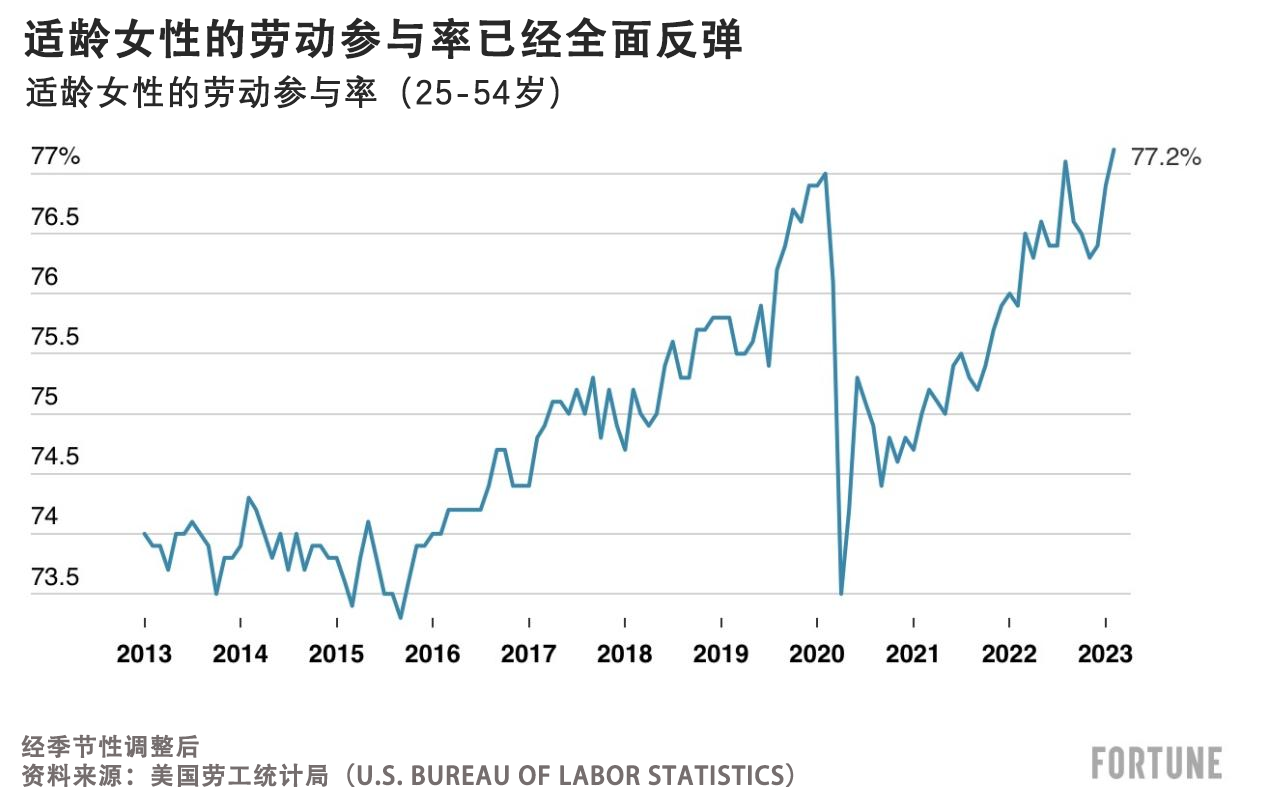女性正在跳过婚姻,成为劳动力中一支不可忽视的力量

在过去十年中,劳动力中未婚单身女性的数量增长速度是整体劳动力数量增长速度的三倍。
如今,女性单身的时间越来越长,其中许多人推迟结婚或者成家,而另一些人则选择永久单身。休斯顿大学(University of Houston)的人类学副教授黛娜·汉纳福德表示,这是一个全球趋势。美国人口普查局(Census Bureau)的数据显示,美国女性初婚年龄中值已经从1956年20.1岁的低点升至2022年的28.2岁。
Wells Fargo Economics最近的一份报告显示,截至2021年,超过一半(52%)的女性未婚或者分居。该报告指出:“随着女性一生中大部分时间作为单个经济单位为经济发展做贡献,她们与劳动力市场的关系正在发生变化。”
尽管推迟或者不结婚背后的原因各不相同,但正如数据所显示的那样,事业在其中扮演了很重要的角色。事实证明,未婚单身女性是劳动力中迅速增长的群体,在所有女性中,她们的参与率最高。例如,根据克利夫兰联邦储备银行(Federal Reserve Bank of Cleveland)的研究,已婚女性的参与率比单身女性低约7个百分点。根据富国银行(Wells Fargo)的研究,未婚单身女性目前占职场人士的16%,高于2012年的13.9%。

未婚女性在劳动力中所占的比例不断增加,这不仅是因为她们的人口数量不断增长,还因为她们往往需要通过工作来维持生计。单身女性,尤其是那些从未结婚的女性,通常只能依靠自己的收入,就更有必要坚守工作岗位。研究人员发现,在过去十年里,未婚女性的劳动参与率上升了1.9个百分点——高于未婚男性的比率。
未婚女性劳动参与率的上升与美国劳动参与率总体稳步下降形成了鲜明的对比(甚至在新冠疫情爆发之前)。报告称:“在过去十年里,美国单身女性数量的增加为美国劳动力提供了急需的支持。”
三年前新冠疫情期间,有1,360万女性失去了工作。职业女性(25岁至54岁)的劳动参与率终于全面反弹。今年2月,77.2%的适龄女性在工作或者积极寻找工作,与新冠疫情爆发前的77%持平。
但在美国,由于诸多不利因素,女性——甚至是未婚单身女性——的就业率仍然低于男性,这些不利因素包括缺乏儿童保育服务、工资差距、税收政策,甚至是政府福利。最新数据显示,男性的劳动参与率仍然比女性高出约12个百分点。
因此,尽管未婚单身女性成为劳动力中一支不可忽视的力量——尤其是在雇主尽力招聘人才的情况下——但要想看到未婚单身女性的财务和经济状况得到持续改善,仍然需要克服诸多挑战。(财富中文网)
译者:中慧言-王芳
在过去十年中,劳动力中未婚单身女性的数量增长速度是整体劳动力数量增长速度的三倍。
如今,女性单身的时间越来越长,其中许多人推迟结婚或者成家,而另一些人则选择永久单身。休斯顿大学(University of Houston)的人类学副教授黛娜·汉纳福德表示,这是一个全球趋势。美国人口普查局(Census Bureau)的数据显示,美国女性初婚年龄中值已经从1956年20.1岁的低点升至2022年的28.2岁。
Wells Fargo Economics最近的一份报告显示,截至2021年,超过一半(52%)的女性未婚或者分居。该报告指出:“随着女性一生中大部分时间作为单个经济单位为经济发展做贡献,她们与劳动力市场的关系正在发生变化。”
尽管推迟或者不结婚背后的原因各不相同,但正如数据所显示的那样,事业在其中扮演了很重要的角色。事实证明,未婚单身女性是劳动力中迅速增长的群体,在所有女性中,她们的参与率最高。例如,根据克利夫兰联邦储备银行(Federal Reserve Bank of Cleveland)的研究,已婚女性的参与率比单身女性低约7个百分点。根据富国银行(Wells Fargo)的研究,未婚单身女性目前占职场人士的16%,高于2012年的13.9%。
未婚女性在劳动力中所占的比例不断增加,这不仅是因为她们的人口数量不断增长,还因为她们往往需要通过工作来维持生计。单身女性,尤其是那些从未结婚的女性,通常只能依靠自己的收入,就更有必要坚守工作岗位。研究人员发现,在过去十年里,未婚女性的劳动参与率上升了1.9个百分点——高于未婚男性的比率。
未婚女性劳动参与率的上升与美国劳动参与率总体稳步下降形成了鲜明的对比(甚至在新冠疫情爆发之前)。报告称:“在过去十年里,美国单身女性数量的增加为美国劳动力提供了急需的支持。”
三年前新冠疫情期间,有1,360万女性失去了工作。职业女性(25岁至54岁)的劳动参与率终于全面反弹。今年2月,77.2%的适龄女性在工作或者积极寻找工作,与新冠疫情爆发前的77%持平。
但在美国,由于诸多不利因素,女性——甚至是未婚单身女性——的就业率仍然低于男性,这些不利因素包括缺乏儿童保育服务、工资差距、税收政策,甚至是政府福利。最新数据显示,男性的劳动参与率仍然比女性高出约12个百分点。
因此,尽管未婚单身女性成为劳动力中一支不可忽视的力量——尤其是在雇主尽力招聘人才的情况下——但要想看到未婚单身女性的财务和经济状况得到持续改善,仍然需要克服诸多挑战。(财富中文网)
译者:中慧言-王芳
The number of single, unmarried women in the workforce has grown three times faster than the overall pool of workers in the past decade.
Women today are spending a larger portion of their lives single, many of whom are waiting longer to marry or start families, while others are opting to remain permanently unattached. It’s a global trend, according to Dinah Hannaford, associate professor of anthropology at the University of Houston. In the U.S., the median age of first marriage for women has risen from a low of 20.1 in 1956 to an estimated age of 28.2 in 2022, according to the Census Bureau.
More than half (52%) of women are unmarried or separated as of 2021, according to a recent report from Wells Fargo Economics. “As women spend a greater portion of their lives as a single economic unit, it is ushering in changes to their relationship with the labor market,” the report notes.
Although the reasons behind delaying or skipping marriage vary, careers play a large role—as the numbers show. Single, unmarried women, as it turns out, are a rapidly growing segment of the labor force, holding the highest participation rate of all women. The participation rate for married women, for example, is about 7 percentage points lower than that for single women, according to research from the Federal Reserve Bank of Cleveland. Unmarried single women now account for 16% of workers, up from 13.9% in 2012, according to the Wells Fargo research.
These unmarried women are increasing their share of the labor force not only because of their growing population numbers, but also because they tend to have a greater financial need for work. Single women, particularly those who have never married, usually only have their own earnings to rely on, creating more of an imperative to hold down employment. Researchers found that the labor force participation rate of never-married women has increased 1.9 percentage points over the last 10 years—higher than the rate of never-married men.
The growing labor force participation rate among unmarried women also stands in contrast to an overall steady decline in the total U.S. participation rate (even prior to the COVID-19 pandemic). “The rising number of single women in the United States has thus provided some much-needed support to the U.S. labor force over the past decade,” the report says.
The labor force participation rate of working women (ages 25 to 54) has finally, fully rebounded after 13.6 million women lost their jobs during the onset of the COVID-19 pandemic three years ago. In February, 77.2% of prime-age women were working or actively looking for a job, on par with the pre-pandemic rate of 77%.
But women—even single unmarried women—are still employed at lower rates in the U.S. than men due to a number of headwinds, including a lack of childcare, wage disparities, tax policies, and even government benefits. The latest data shows men’s workforce participation is still roughly 12 points higher than women.
So while single women who have never married are increasingly a critical labor source—particularly as employers continue to struggle with recruiting—there are still challenges to overcome to see continued financial and economic improvement for this sector of the population.













